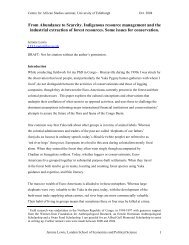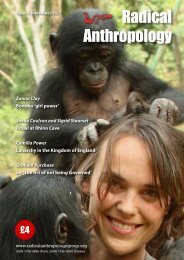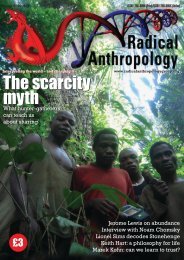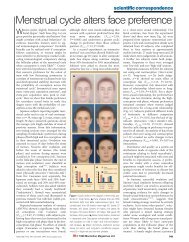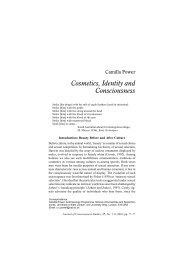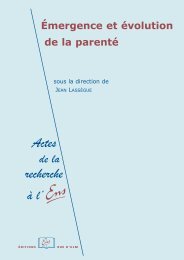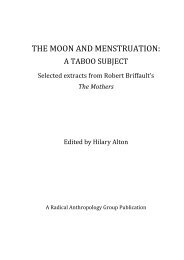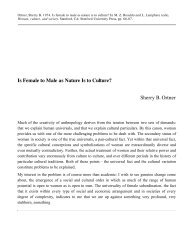Language and life history: A new perspective on the development ...
Language and life history: A new perspective on the development ...
Language and life history: A new perspective on the development ...
- No tags were found...
Create successful ePaper yourself
Turn your PDF publications into a flip-book with our unique Google optimized e-Paper software.
Locke & Bogin: <str<strong>on</strong>g>Language</str<strong>on</strong>g> <str<strong>on</strong>g>and</str<strong>on</strong>g> <str<strong>on</strong>g>life</str<strong>on</strong>g> <str<strong>on</strong>g>history</str<strong>on</strong>g>used simply to store knowledge, [...] but to engage o<strong>the</strong>rsin verbal <str<strong>on</strong>g>and</str<strong>on</strong>g> intellectual combat: utterance of <strong>on</strong>e proverbor riddle challenges hearers to top it with a more appositeor a c<strong>on</strong>tradictory <strong>on</strong>e” (p. 44). Later we will revisit this“ag<strong>on</strong>istic” property.4.2. Speech, attenti<strong>on</strong>, <str<strong>on</strong>g>and</str<strong>on</strong>g> powerIf <strong>the</strong>re are links between speech <str<strong>on</strong>g>and</str<strong>on</strong>g> attenti<strong>on</strong>, as <strong>the</strong>anthropological literature suggests, <strong>the</strong>n individuals mayuse speech as “an advertising device,” <str<strong>on</strong>g>and</str<strong>on</strong>g> “will competewith each o<strong>the</strong>r in eloquence to draw attenti<strong>on</strong> to <strong>the</strong>mselves<str<strong>on</strong>g>and</str<strong>on</strong>g> to obtain status from <strong>the</strong> audience” (Dessalles1998, p. 142). In many oral societies, speech <str<strong>on</strong>g>and</str<strong>on</strong>g> status,or power, go h<str<strong>on</strong>g>and</str<strong>on</strong>g> in h<str<strong>on</strong>g>and</str<strong>on</strong>g>. These societies are locatedin places as dispersed as:New Zeal<str<strong>on</strong>g>and</str<strong>on</strong>g>, where, am<strong>on</strong>g <strong>the</strong> Maori, “oratory is <strong>the</strong>prime qualificati<strong>on</strong> for entry into <strong>the</strong> power game”(Salm<strong>on</strong>d 1975, p. 50).Central Peru, where <strong>the</strong> Amuesha people “describe a trueleader as ... ‘<strong>the</strong> <strong>on</strong>e who is powerful due to his or herwords’” (Santos-Granero 1991, p. 301).Ethiopia, where, am<strong>on</strong>g <strong>the</strong> Mursi, “<strong>the</strong> most frequentlymenti<strong>on</strong>ed attribute of an influential man is his abilityto speak well in public” (Turt<strong>on</strong> 1975, p. 176).Central Brazil, where “plaza speech, described as “a politicallyimportant act” (Seeger 1981, p. 185).Nor<strong>the</strong>rn Transvaal, where, am<strong>on</strong>g <strong>the</strong> Venda people, “Thegreatest h<strong>on</strong>our seems to be accorded to those who canmanipulate words <str<strong>on</strong>g>and</str<strong>on</strong>g> sentences” (Blacking 1961, p. 4).The Trobri<str<strong>on</strong>g>and</str<strong>on</strong>g> Isl<str<strong>on</strong>g>and</str<strong>on</strong>g>s, where <strong>the</strong> tribal leaders, or “Bigmen,” have also been called “rhetoric thumpers” (Reay1959).South Africa, where <strong>the</strong> Tshidi people c<strong>on</strong>sider oratoricalability as “a significant comp<strong>on</strong>ent of political success<str<strong>on</strong>g>and</str<strong>on</strong>g> <strong>the</strong> means by which politicians dem<strong>on</strong>strate <strong>the</strong>iracumen” (Comaroff 1975, p. 143).Inner city neighborhoods of Philadelphia, where <strong>the</strong>African-American “man of words, <strong>the</strong> good talker, hasan important place in <strong>the</strong> social structure of <strong>the</strong> group,not <strong>on</strong>ly in adolescence but throughout most of his<str<strong>on</strong>g>life</str<strong>on</strong>g>” (Abrahams 1970a, p. 44).South America, where “Speaking is more than a privilege,it is a duty of <strong>the</strong> chief. It is to him that <strong>the</strong> mastery ofwords falls.” Throughout <strong>the</strong> c<strong>on</strong>tinent, “It can be saidnot that <strong>the</strong> chief is a man who speaks, but that hewho speaks is a chief” (Clastres 1987, p. 41).This relati<strong>on</strong>ship between speech <str<strong>on</strong>g>and</str<strong>on</strong>g> power may belinked to a c<strong>on</strong>necti<strong>on</strong> between speech <str<strong>on</strong>g>and</str<strong>on</strong>g> attenti<strong>on</strong>, <strong>on</strong>ein which vocal loudness plays a role. “A great Maoriorator,” wrote Salm<strong>on</strong>d (1975), “jumps to his feet with aloud call <str<strong>on</strong>g>and</str<strong>on</strong>g> immediately dominates <strong>the</strong> speakingground”(p. 56). Am<strong>on</strong>g <strong>the</strong> Pa’ikwené, “good speaking”involves speech that is “str<strong>on</strong>g in t<strong>on</strong>e <str<strong>on</strong>g>and</str<strong>on</strong>g> volume ...speaking loud-<str<strong>on</strong>g>and</str<strong>on</strong>g>-str<strong>on</strong>g embodies a pers<strong>on</strong>’s health,strength, <str<strong>on</strong>g>and</str<strong>on</strong>g>, bey<strong>on</strong>d that, humanness” (Passes 2004, p. 8).The effect of vocal-verbal behavior <strong>on</strong> attenti<strong>on</strong> <str<strong>on</strong>g>and</str<strong>on</strong>g><strong>the</strong>n status is evident as early as childhood. In a classroomstudy of three- to six-year-old German kindergartners,Hold-Cavell <str<strong>on</strong>g>and</str<strong>on</strong>g> Borsutzky (1986) found that glanceswere frequently preceded by speech, <str<strong>on</strong>g>and</str<strong>on</strong>g> that childrenwho attracted attenti<strong>on</strong> to <strong>the</strong>mselves by verbalizingearly in <strong>the</strong> school year were far more likely than o<strong>the</strong>rsto rank highly at <strong>the</strong> end of <strong>the</strong> year. In adulthood, individualswho speak in l<strong>on</strong>g sentences or hold <strong>the</strong> floor for l<strong>on</strong>gperiods of time tend to receive more gazes than o<strong>the</strong>rs,<str<strong>on</strong>g>and</str<strong>on</strong>g> to be perceived as unusually powerful (Abramovitch1976; Bales et al. 1951; Dabbs & Ruback 1984; Exlineet al. 1975; Kalma 1991; Kend<strong>on</strong> & Cook 1969; Mulac1989).4.3. Verbal performanceVerbal performances <str<strong>on</strong>g>and</str<strong>on</strong>g> competiti<strong>on</strong>s have been documentedin oral cultures located, diversely, in Africa,Asia, South America, Mexico, <str<strong>on</strong>g>and</str<strong>on</strong>g> several differentplaces in North America (Ayoub & Barnett 1965;Dundes et al. 1970; Faris 1966; Gossen 1976b). These performancestake a number of forms – in African-Americangroups, for example, rapping, shucking <str<strong>on</strong>g>and</str<strong>on</strong>g> jiving, coppinga plea, gripping, <str<strong>on</strong>g>and</str<strong>on</strong>g> sounding (<strong>on</strong>ce known as “playing <strong>the</strong>dozens”). Each of <strong>the</strong>se forms “must be judged as performanceart,” according to Abrahams (1970b), <strong>the</strong> evaluati<strong>on</strong>based less <strong>on</strong> “<strong>the</strong> elements of <strong>the</strong> compositi<strong>on</strong>, suchas complexity <str<strong>on</strong>g>and</str<strong>on</strong>g> originality,” than <strong>on</strong> its “sp<strong>on</strong>taneity,virtuosity, <str<strong>on</strong>g>and</str<strong>on</strong>g> comm<str<strong>on</strong>g>and</str<strong>on</strong>g>” (p. 147). 7 One also finds inanthropological literatures various references to <strong>the</strong> useof <strong>the</strong> voice without speech, whe<strong>the</strong>r in <strong>the</strong> s<strong>on</strong>gs of <strong>the</strong>Suya Indians of Brazil (Seeger 1981), <strong>the</strong> s<strong>on</strong>g challengesof <strong>the</strong> Fiji Indians (Brenneis & Padarath 1975), or <strong>the</strong> s<strong>on</strong>gduels or drum s<strong>on</strong>gs of Eskimos (Hoebel 1964; Mirsky1937).The social value of performative speech has beenattested by African-American teenagers in Los Angeles.Folb (1980) interviewed a black teenage boy who said,“yo’ rap is your thing. I’s like your pers<strong>on</strong>ality. Like youkin style <strong>on</strong> some dude by rappin’ better’n he do.Show’im up. Outdo him c<strong>on</strong>versati<strong>on</strong>-wise.” Folb commented,“Who you are (<str<strong>on</strong>g>and</str<strong>on</strong>g> very often how well yousurvive) depends ... heavily <strong>on</strong> how well you talk.”Words, she said, “are tools for power <str<strong>on</strong>g>and</str<strong>on</strong>g> gain ... a goodrap can save your <str<strong>on</strong>g>life</str<strong>on</strong>g>” (p. 90). That rapping is more of aperformance than a verbal exchange is suggested by <strong>the</strong>fact that African-American men in Chicago ghettos rapto ra<strong>the</strong>r than with <strong>the</strong>ir peers (Kochman 1969).Kochman found that rapping <str<strong>on</strong>g>and</str<strong>on</strong>g> <strong>the</strong> o<strong>the</strong>r verbal registersenable <strong>the</strong> speaker “to manipulate <str<strong>on</strong>g>and</str<strong>on</strong>g> c<strong>on</strong>trolpeople <str<strong>on</strong>g>and</str<strong>on</strong>g> situati<strong>on</strong>s to give himself a winning edge”(p. 34).It is of more than passing interest that many of <strong>the</strong>actors in traditi<strong>on</strong>al verbal performances have been male.For example:Am<strong>on</strong>g <strong>the</strong> Limba people of Sierra Le<strong>on</strong>e, “it is a specificallymasculine quality to be able to ‘speak’ well”(Finnegan 1967, p. 70).In an Ethiopian village studied by Turt<strong>on</strong> (1975), publicspeaking was “a prerogative of adult males” (p. 170).The orators in South Bali, according to Hobart (1975),were “usually adult men aged from thirty to sixty withreputati<strong>on</strong>s for <strong>the</strong>ir knowledge of law <str<strong>on</strong>g>and</str<strong>on</strong>g> persuasivenessas speakers” (p. 77).268 BEHAVIORAL AND BRAIN SCIENCES (2006) 29:3



